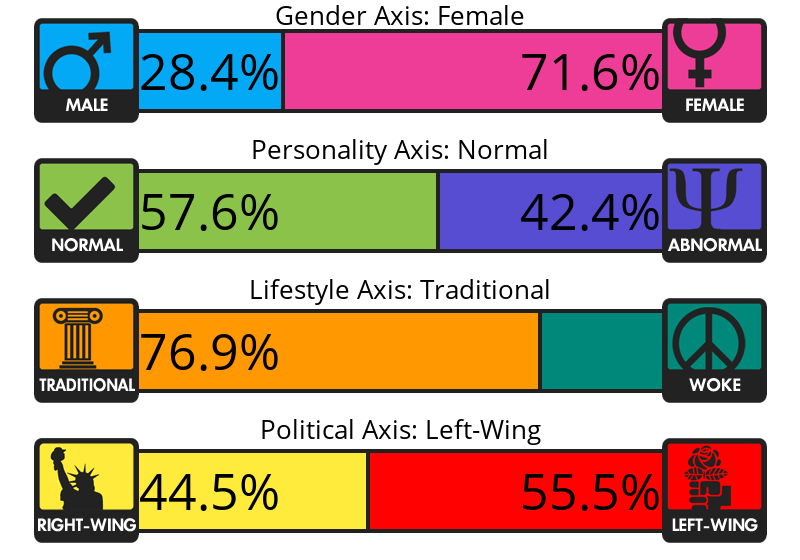4 Axes Test
You are here because one of your friends linked you to their 4 Axes Test result:
Take the TestResults:

Explanation of Axes:
Gender Axis: Measures whether your interests and personality traits are more like those of men or women in the global population. For more on the empirical basis of gender and gender roles, see also the Gender Role Test (based on the findings of Sandra Bem) or the Gender Coordinates Test (based on the findings of Heilman and Peus).
Personality Axis: Measures whether your personality is normal or abnormal. Having abnormal traits does not necessarily mean that one is crazy or that one could be diagnosed with a personality disorder; merely that one shares traits or features with such people. See also the Personality Style Test (based on the findings of Beck and Millon) or the Personality Maladaptation Test (based on research from the American Psychiatric Association).
Lifestyle Axis: Measures whether your lifestyle is traditional and conservative or progressive and “woke.” Note that traditional/conservative people on this axis are not necessarily politically right-wing but may be center-left, as for example both H.J. Eysenck and Eric Kaufmann have found that many left-wingers are conservative in terms of their values and temperament. See also the Eysenck Political Test or the Moral Vignettes Test for more on the intersection between values and outlook.
Political Axis: Measures whether your political outlook is more right-wing or left-wing according to a set of items that very broadly code for left or right in one’s political orientation. That is to say, this axis does not distinguish between conservatives and libertarians on the right, or between left-liberalist and socialists on the left, but merely gives an indication of whether you are left or right. See also the Political Coordinates Test or Political Left/Right Test for other ways of measuring political standpoints.
References
- Donnelly & Twenge: Masculine and Feminine Traits on the Bem Sex-Role Inventory, 1993–2012: a Cross-Temporal Meta-Analysis (Sex Roles 0360-0025 2016)
- Holt & Ellis: Assessing the Current Validity of the Bem Sex-Role Inventory (Sex Roles Volume 39, Issue 11-12 1998)
- Holt & Ellis: Assessing the Current Validity of the Bem Sex-Role Inventory (Sex Roles Volume 39, Issue 11-12 1998)
- Graham, J., Nosek, B. A., Haidt, J., Iyer, R., Koleva, S., Ditto, P.: Mapping the Moral Domain Journal of Personality and Social Psychology 101(2), 2011
- Graham, J., Haidt, J., Nosek, Brian A.: Liberals and Conservatives Rely on Different Sets of Moral Foundations Journal of Personality and Social Psychology 96, 2009
- Wilson, G. D., & Brazendale, A. H. (1973). Social Attitude Correlates of Eysenck’s Personality Dimensions. Social Behavior and Personality: An International Journal, 1(2), 115–118
- Anderson, J. L., Sellbom, M., & Salekin, R. T. (2018). Utility of the Personality Inventory for DSM-5–Brief Form (PID-5-BF) in the measurement of maladaptive personality and psychopathology. Assessment, 25, 596-607
- Fossati, A., Somma, A., Borroni, S., Markon, K. E., & Krueger, R. F. (2017). The Personality Inventory for DSM-5 Brief Form: Evidence for reliability and construct validity in a sample of community-dwelling Italian adolescents. Assessment, 24, 615-631
GET THE FULL STORY
Become a lifetime member with a one-time payment
WHAT YOU GET
Access to premium, members-only tests
Access to all of our eBooks (value $44.94)
Access to 100s of premium articles
Access to 100s of premium type assessments
Access to premium infographics
New content continuously added
Become a member